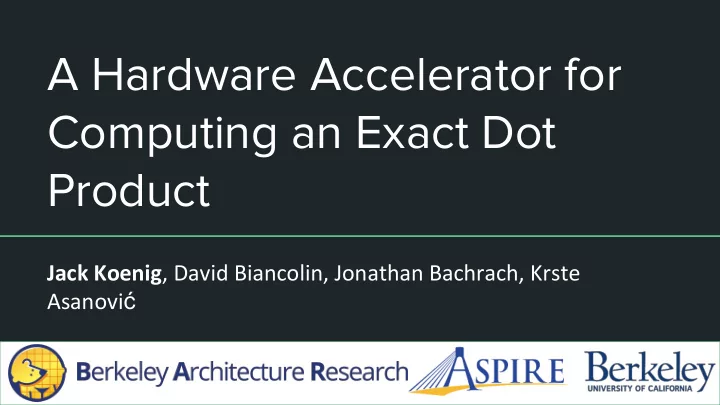

A Hardware Accelerator for Computing an Exact Dot Product Jack Koenig , David Biancolin, Jonathan Bachrach, Krste Asanovi ć 1
Challenges with Floating Point Addition and multiplication are not associative 10 20 + 1 - 10 20 = 0 Multithreaded, not even reproducible! 10 20 + 1 - 10 20 = 0 or 1 Solutions MPFR - Exact but much slower than hardware ● ● ExactBLAS - Faster than MPFR, still slower than hardware ● ReproBLAS - Fast and reproducible, but not exact 2
Moore’s Law Winding Down [Hennessy & Patterson, 2017] 3
S p e c i a l i z a t i o n i s a From Moore’s Law to Dark Silicon l r e a d y h e r e ! ● System-on-Chips have billions of transistors Power density constraints prevent all ● transistors from being used at once ● Accelerators orders-of-magnitude more efficient than CPUs Can turn off unused specialized units ● to save power ⇒ Use those extra transistors for specialized hardware NVIDIA Tegra 2 4
Motivation Why Dot Product? 1) A kernel of many applications 2) Reduction is good candidate for exact representation Why Exact? Simplifies error analysis 5
Related Work ● We were heavily influenced by the work of Ulrich Kulisch et. al ○ XPA 3233 in 1994 ○ PCI-based co-processor ○ 0.8um process ● Recently, Uguen and Dinechin published a design-space exploration for FPGA-hosted implementations of Kulisch’s design [XPA 3233] 6
Principle of Operation ● Fixed point representation of entire space 1 + 2 ⨉ (2 bits(exp) + bits(mant)) ○ ○ 2100 bits to represent 1 double-precision number 4200 bits for product of 2 doubles ○ ○ 88 bits to preclude overflow 4288 bits in our complete representation (CR) ○ ● Accumulation ○ Fetch elements of each vector from memory ○ Calculate product of the mantissas and sum of the exponents ○ Use sum of exponents to align product of mantissas with complete representation ○ Accumulate ○ Propagate carry or borrow if necessary [Kulisch 2008] 7
System Architecture Rocket Chip Generator A RISC-V processor generator ● ● RISC-V is an open-source, extensible ISA ● Provides Rocket Custom Coprocessor Interface (RoCC) Used in over 12 academic tapeouts and at least 1 commercial tapeout EOS 22 (2014) 8
RoCC Accelerator ● Integrated with Rocket Chip via RoCC 5 stage in-order pipeline (Rocket) ○ ○ 32 KiB L1 instruction and data caches 256 KiB L2 cache ○ ● Instructions are fetched by Rocket core and forwarded to the accelerator ● Memory interface is parameterized for ○ 64-bit L1 cache interface ○ 128-bit L2 cache interface 9
Instructions Name Description CLR_CR Clear the complete register RD_DBL/RD_FLT Round the complete register and return the result to a general-purpose register LD_CR Loads a complete register from memory ST_CR Stores the complete register to memory ADD_CR Adds a complete register in memory to the current value PRE_DP Initializes vector base address registers RUN_DP Specifies vector length; instructs accelerator to begin computation 10
11
Control & Memory Unit Control Unit Decodes instructions ● ● Rounds complete register Memory Unit ● Fetches operands from memory and re-orders responses to feed to datapath Parameterized for 64-bit L1 or 128-bit ● L2 interface 12
Segmented Accumulator ● Divide complete register into segments ● Each segment gets its own adder Accumulates a portion of the product of the mantissas and incoming ● carry/borrow 13
Centralized Accumulator ● Uses a single adder ● For double, product of mantissas gives 104-bit summand ● Read appropriate 4 words from accumulator based on sum of exponents Add summand to lower-order 3 words, ● propagated carry/borrow into 4th ● Stall if carry or borrow propagates beyond all_ones, all_zeros helps with ● propagation 14
Methodology & Evaluation Overview Performance evaluation requires both cycles-per-dot-product and cycle time. 1) Cycles-per-dot-product: ○ Simulate the SoC in RTL simulation, measure execution time in cycles 2) Cycle time: ○ Push SoC through synthesis and P&R, determine critical path, area Design space exploration over three parameters: {C,S}_{L1,L2}_{D,F} Complete Register Cache Interface Operand Precision (Centralized, Segmented) (L1 = 64 bit, L2 = 128 bit) (Double, Float) 15
Measuring Cycles-Per-Operation ● simulate entire SoC in RTL simulation (Synopsys VCS) ● microbenchmark: random vectors uniformly in the mantissa and exponent spac measure cycles-per-element (CPE) of software libraries on a host with similar ● caches: Software libraries: ● ReproBLAS ● Intel MKL Host machine: Intel Xeon E5-2667 ● caches: 32 KiB L1 D$, 256 KiB unified L2 ● ISA extensions: SSE 4.1, 4.2, AVX 16
Comparison: CPE vs Vector Length Single Precision Double Precision 17
VLSI Evaluation Push the complete SoC through CAD flow, measure cycle time and area. Flow details: ● Synthesis: Synopsys Design Compiler ● Place & Route: Synopsys IC Compiler Technology: TSMC 45nm ● ● No SRAM compiler ○ generate timing and area models using CACTI 18
Area Breakdown of Accelerator 19
Area Breakdown of Core excluding L2 s n 9 0 . 1 s n 4 2 . 1 20
Outstanding Questions & Future Work ● How to use effectively in BLAS-2 and BLAS-3 kernels? Must amortize overhead of accelerator setup ○ ○ Cost of saving intermediate exact results is high ● Measure energy and compare to software libraries. ○ Compare to software libraries. 21
Conclusion ● Realizable with modest area costs ● Easily saturates available memory bandwidth Strong case for integration in application specific SoCs; more careful evaluation required to motivate integration in general-purpose machines 22
Acknowledgements ● Special thanks to Jim Demmel, William Kahan, Hong Diep Nguyen, and Colin Schmidt This research was partially funded by DARPA Award Number ● HR0011-12-2-0016 and ASPIRE Lab industrial sponsors and affiliates Intel, Google, HPE, Huawei, LGE, Nokia, NVIDIA, Oracle, and Samsung. 23
Recommend
More recommend